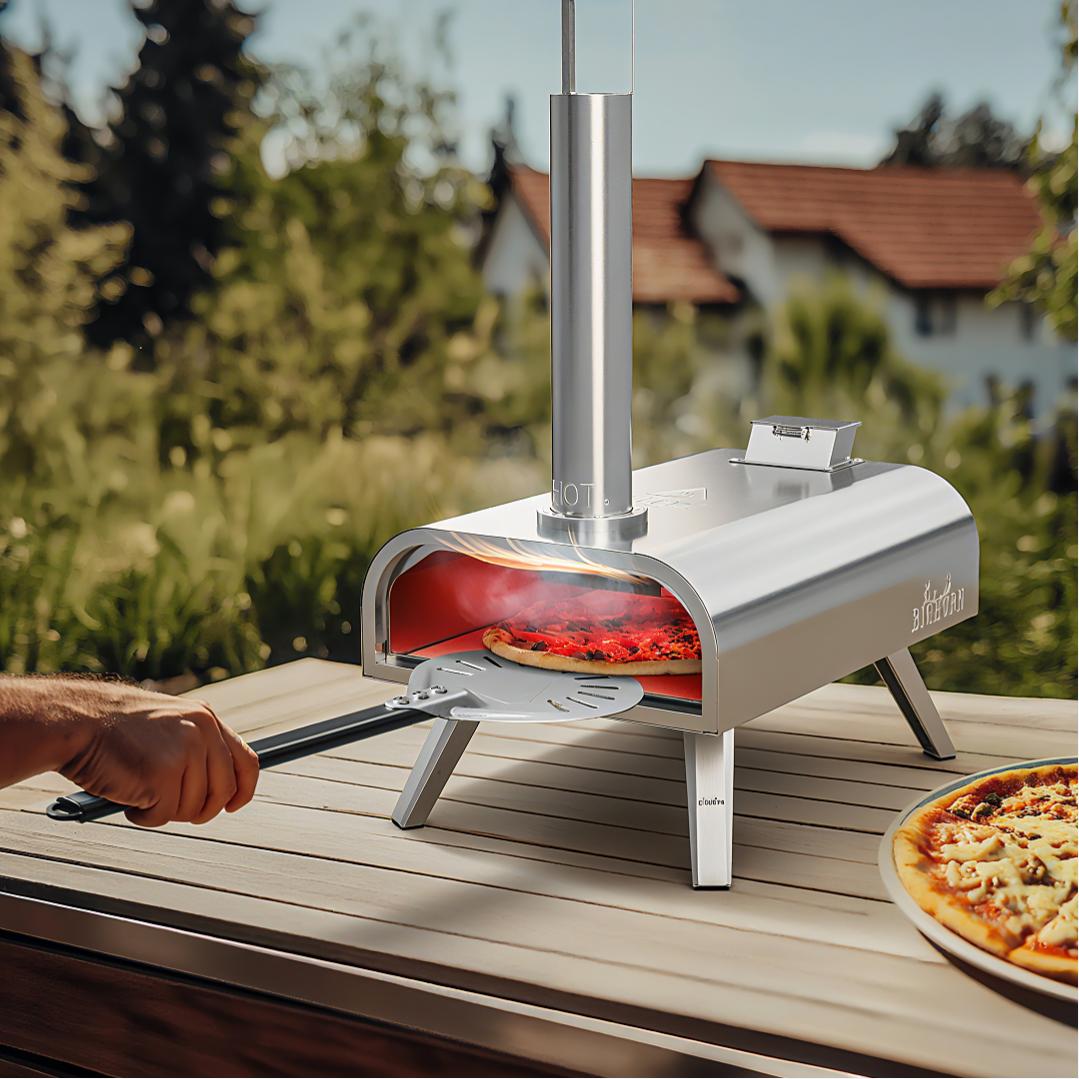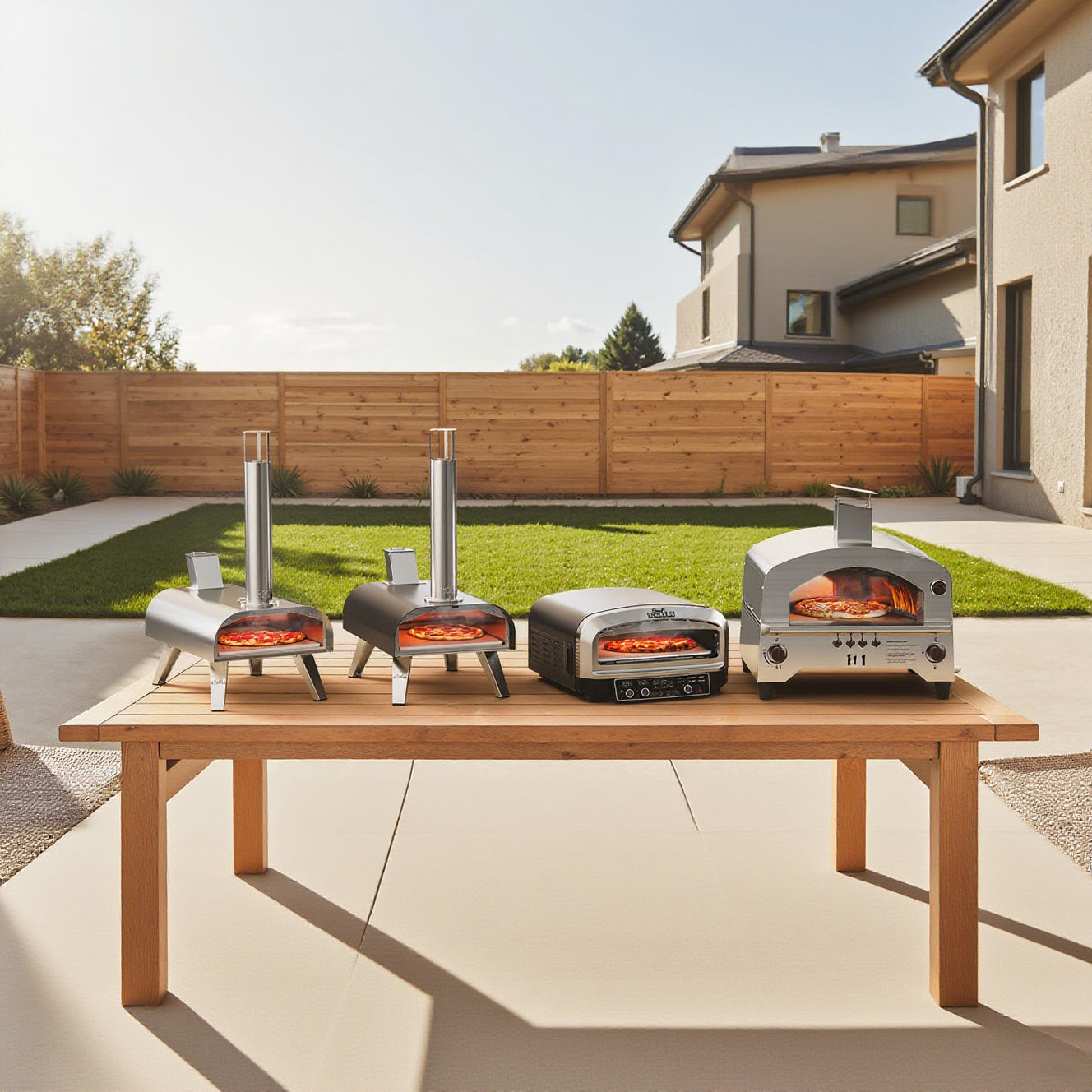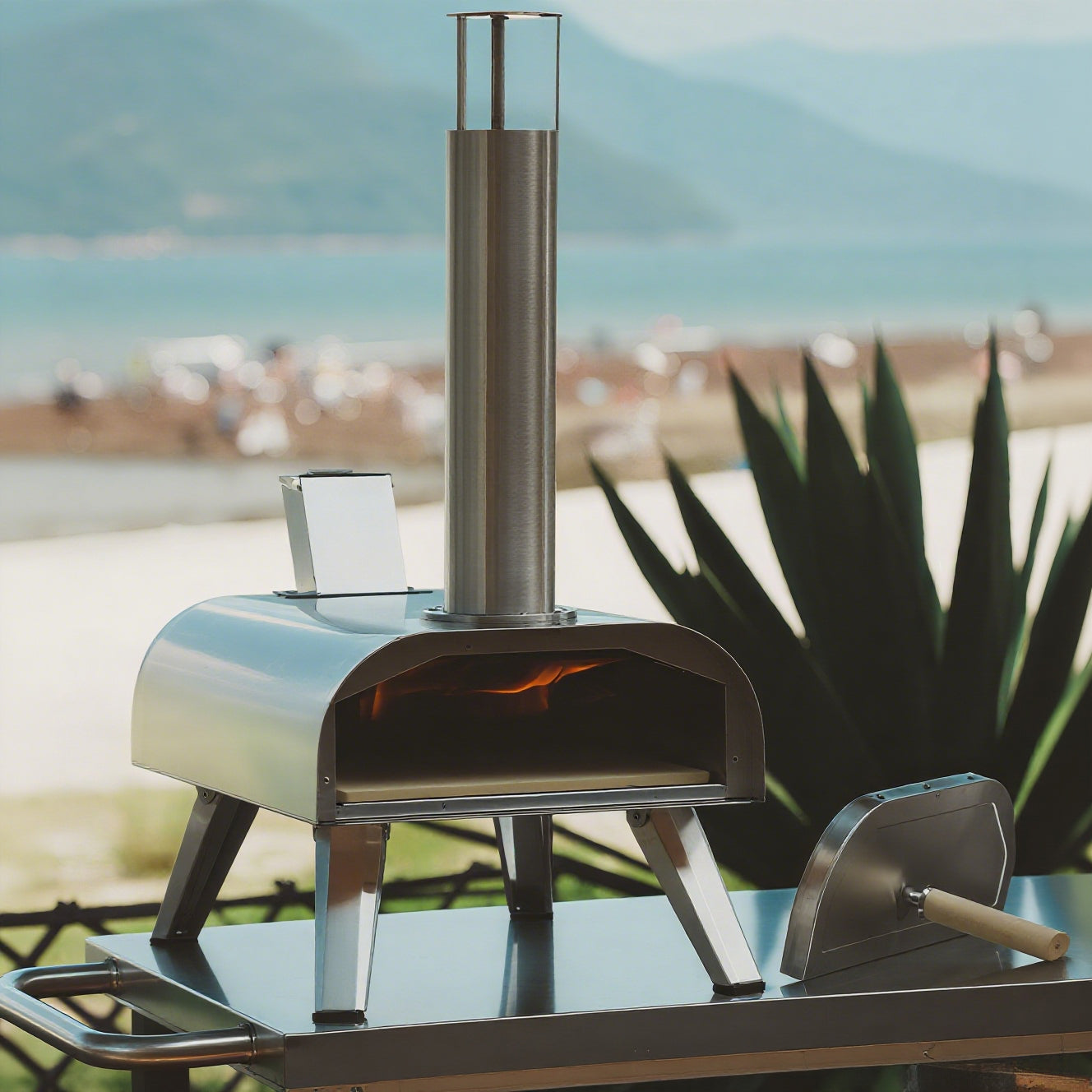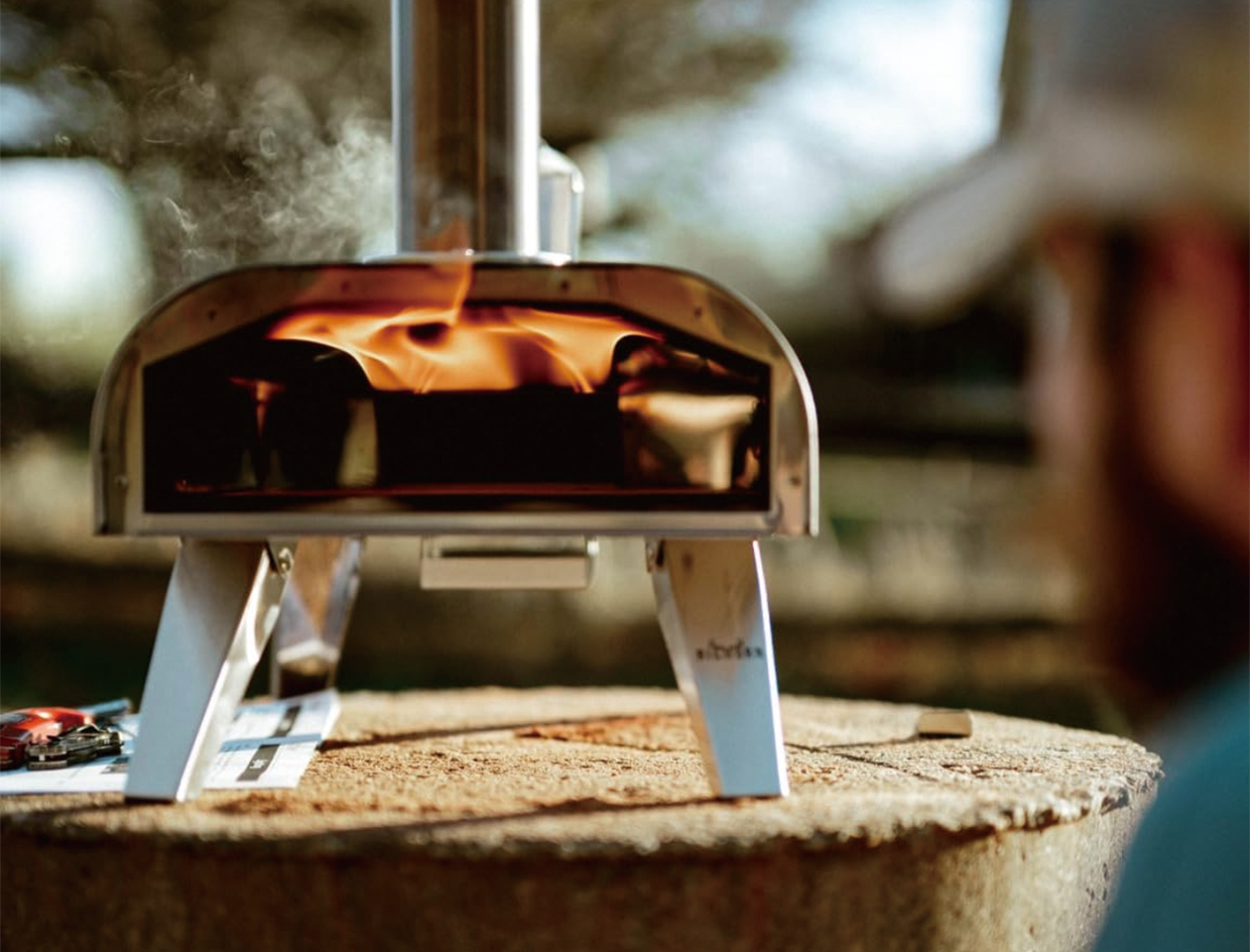Hosting a pizza party is always fun—especially when you're the one crafting homemade pies with fresh ingredients and your favorite toppings. You use a pizza oven to make the best pizza and share it with your family and friends—this is the magic of making pizza at home.
But with so many pizza ovens on the market: wood, gas, and electric...it can be tricky to pick the right one. Which type of oven should you get?
This guide will break down the wood-fired vs. gas vs. electric pizza ovens to help you find your perfect match, and maybe turn your backyard into the best pizzeria in town.
Wood-Fired Pizza Ovens
Wood-fired pizza ovens are the traditional choice that many pizza lovers swear by. These ovens burn wood directly inside the cooking chamber, creating intense heat and that signature smoky flavor.
These traditional ovens are typically built with brick or stone construction, making them heavy and commonly used in restaurants and commercial settings. However, there are now portable pellet pizza ovens that bring wood-fired cooking to home backyards.
How it Works
Traditional wood-fired ovens use logs of hardwood like oak, hickory, or cherry. You build a fire inside the oven dome, and the flames heat the walls and floor to extremely high temperatures.
Once the wood burns down to coals, you push them to one side and cook pizzas on the hot stone floor.
Pellet ovens work similarly but use compressed wood pellets instead of logs. These pellets feed automatically into the fire, making temperature control easier while still giving you authentic wood-fired taste.
Key Characteristics
Pros:
- Authentic smoky flavor that you can't get from other fuel types
- Extremely high heat - can reach over 900°F for perfect Neapolitan-style pizza
- Great for other foods like bread, roasted vegetables, and meat
- Low fuel costs - wood and pellets are usually the cheapest option
- Creates a fun, social cooking experience
Cons:
- Takes time to learn - managing fire temperature requires practice
- Long heat-up time - typically 45 to 90 minutes for traditional ovens (portable pizza ovens typically 18-20 minutes)
- Weather affects performance - rain and wind can make it difficult to use
- Requires wood storage - you need a dry place to keep fuel
- Produces smoke and ash- may not work in all neighborhoods
- Can't leave it unattended - requires constant monitoring
Ideal Users/Scenarios
Wood-fired pizza ovens work best for people who enjoy the traditional cooking process and have time to dedicate to it. They're perfect if you have outdoor space, supportive neighbors, and love the authentic taste that only wood smoke can provide.
This is the traditional approach, and there are more modern alternatives like gas ovens that give convenience.
Gas Pizza Ovens
Gas pizza ovens run on propane or natural gas and use burners to heat the oven. You still get high heat for great pizza, but without the hard work of managing wood, offering a good balance of flavor and convenience.
How it Works
Unlike wood-fired ovens, gas pizza ovens are much easier to use. The burners sit under or around the cooking surface. You just turn on the gas, press the ignition button, and set the temperature.
Most models reach 800–900°F, which is enough for crispy, well-cooked pizza.
Also, the clean flame heats the oven evenly, so you get great results without needing to manage a fire.
Key Characteristics
Pros:
- Quick and easy - ready to cook in 15-20 minutes
- Precise temperature control - adjust heat exactly where you want it
- Works in any weather - rain and wind won't affect performance
- Very clean - no ash, minimal smoke, easy cleanup
- Consistent results every time you cook
- Low maintenance compared to wood-fired ovens
- Can adjust temperature while cooking
Cons:
- Higher fuel costs - gas is more expensive than wood per cooking session
- Have to monitor propane levels to avoid running out mid-cook
- Less "wow factor" - doesn't create the same social atmosphere as wood fire
Ideal Users/Scenarios
Gas ovens are perfect for busy families who want great pizza without a lot of preparation time. They work well in urban areas where smoke might be a problem and for people who value reliability and consistent results over traditional cooking methods.
While gas offers convenience, some people want even more simplicity. That's where electric ovens come in.
Electric Pizza Ovens
Electric pizza ovens are the easiest to use. You just plug them into a regular outlet and control the temperature with simple buttons or a screen.
How it Works
Electric pizza ovens use heating elements (usually at the top and bottom) to create heat. Many models have digital displays where you can set exact temperatures, timers, and even pre-programmed cooking cycles.
Simply plug in, set your temperature, and wait for the oven to heat up.
While most electric ovens can't reach the extreme temperatures of wood or gas models, many achieve 700-850°F, which is still good for delicious homemade pizza.
Key Characteristics
Pros:
- Ultimate convenience - just plug in and cook
- Precise digital controls - set exact temperatures and times
- Can use indoors or outdoors - many models work in both locations
- Almost no maintenance - no fuel storage or gas connections needed
- Weather-proof operation - works consistently regardless of conditions
Cons:
- Temperature limits - most can't get as hot as gas or wood ovens
- Highest operating costs - electricity is usually the most expensive fuel
- May need special outlet - larger models require dedicated electrical circuits
- Limited flavor options - can't create smoky or charred tastes
- Power dependent - won't work during electrical outages
Ideal Users/Scenarios
Electric pizza ovens are great if you live in an apartment or just want something easy to use. They're perfect for beginners and anyone who wants to make pizza often without much work. The results are consistent, though the flavor isn’t as smoky as wood-fired.
And for those who can't decide between different fuel types, dual-fuel ovens offer an interesting solution.
Dual-Fuel Pizza Ovens
Pellet & Electric
Some manufacturers now make ovens that can use both wood pellets and electricity, giving you the best of both worlds.
How it Works
These innovative ovens have both pellet feeding systems and electric heating elements.
You can choose pellet mode when you want authentic smoky flavor, or switch to electric mode when you need quick, convenient cooking.
Key Characteristics
Pros:
- Maximum flexibility - choose wood flavor or electric convenience based on your mood
- Weather backup - use electric mode when weather makes pellets difficult
- Fuel options - pick the most economical fuel for each cooking session
- Reliable performance - electric backup ensures you can always cook
Cons:
- Higher purchase price - advanced technology costs more upfront
- Two systems to maintain - both pellet and electric components need care
- More complex - additional components mean more things that could break
- Learning curve - need to master two different cooking methods
Ideal Users/Scenarios
Great for home cooks who want more control and don’t mind spending extra for top features. Also a smart choice if you cook outside in different weather and want both real wood-fired flavor and a backup heat source.
Pellet & Gas
Another dual-fuel option combines wood pellets and gas burners, offering quick heating with the option for wood-fired flavor.
How it Works
These ovens feature both pellet systems and gas burners.
You can start with gas for quick heat-up, then switch to pellets for flavor, or use both together for optimal performance.
Advanced models let you blend both fuel types for custom cooking profiles.
Key Characteristics
Pros:
- Fast heat-up with gas, enhanced flavor from pellets
- Choose fuel based on time and taste preferences
- High temperature capability from both fuel types
Cons:
- Must stock two different fuels - pellets and gas
- Higher operating costs - premium convenience costs more
Ideal Users/Scenarios
Best for people who love outdoor cooking and often host friends or family. It’s a great choice if you want to switch between fast cooking and rich flavor.
But you'll need to have enough space and budget for high-end gear.
Pizza Oven Comparison at a Glance
With all these options above, it helps to see them compared side by side.
| Feature | Wood-Fired | Gas | Electric | Pellet/Electric | Pellet/Gas |
| Heat-up Time |
45-90 min (traditional) / 18-20 min (portable) |
15-20 min | 10-20 min | Variable | Variable |
|
Max Temperature (general data) |
900°F+ | 800-900°F | 700-850°F | 900°F+ | 900°F+ |
| Fuel Cost | Lowest | Medium | Highest | Medium | Medium |
| Flavor Authenticity | Best | Good | Limited | Best | Best |
| Ease of Use | Difficult | Easy | Easiest | Moderate | Moderate |
| Weather Issues | High | Medium | Low | Low | Medium |
| Maintenance | Most | Little | Least | Moderate | Moderate |
| Learning Required | Most | Some | None | Moderate | Moderate |
| Purchase Price | Low-Medium | Medium | Medium-High | High | Highest |
So according to the chart, let's get the final suggestion:
- If you want the most authentic flavor, go for a wood-fired, pellet/electric, or pellet/gas oven. They offer the best taste.
- If you prefer something easy to use, choose an electric oven. It heats up fast, needs almost no maintenance, and has no learning curve.
- If you live in an area with bad weather, a gas or pellet/gas oven is your best bet, as they handle wind and rain much better than wood-fired models.
- If you're on a budget, consider a wood-fired or electric oven. Wood is the cheapest fuel, and both types are usually affordable to buy.
- If you need high heat for perfect pizza, pick a wood-fired, pellet/electric, or pellet/gas oven. They can reach 900°F or more, which is great for Neapolitan-style results.
Conclusion
So which factor matters the most to you? Flavor? Ease of use? Or cost? No matter which one, make sure you know each type's pros and cons well to make the best decision.
Whether you choose traditional or modern models, the right oven will help you create amazing homemade pizzas, and bring your family and friends together.




